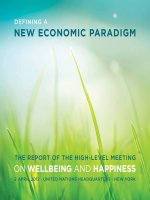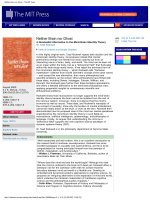the mit press perspectives on free and open source software jun 2005
Bạn đang xem bản rút gọn của tài liệu. Xem và tải ngay bản đầy đủ của tài liệu tại đây (7.45 MB, 571 trang )
MD DALIM #800602 5/8/05 YELO CYAN
TEAM LinG
Perspectives on Free and Open Source SoftwarePerspectives on Free and Open Source Software
The MIT Press
Cambridge, Massachusetts
London, England
edited by
Joseph Feller, Brian Fitzgerald, Scott A. Hissam, and Karim R. Lakhani
© 2005 Massachusetts Institute of Technology
All rights reserved. No part of this book may be reproduced in any form by any
electronic or mechanical means (including photocopying, recording, or information
storage and retrieval) without permission in writing from the publisher.
MIT Press books may be purchased at special quantity discounts for business or sales
promotional use. For information, please e-mail or
write to Special Sales Department, The MIT Press, 5 Cambridge Center, Cambridge,
MA 02142.
This book was set in Stone sans and Stone serif by SNP Best-set Typesetter Ltd.,
Hong Kong. Printed and bound in the United States of America.
Library of Congress Cataloging-in-Publication Data
Perspectives on free and open source software / edited by Joseph Feller . . . [et al.].
p. cm.
Includes bibliographical references and index.
ISBN 0-262-06246-1 (alk. paper)
1. Shareware (Computer software) 2. Open source software. 3. Computer
software—Development. I. Feller, Joseph, 1972–
QA76.76.S46P47 2005
005.36—dc22
2004064954
10987654321
My love, thanks and humble apologies go to my very patient and
supportive family: Carol, Caelen, Damien, and Dylan.
JF
Arís as Gaeilge: Buíochas mór le mo chlann, Máire, Pól agus Eimear. Is mór
agam an iarracht a rinne sibh ar mo shon.
BF
With heartfelt warmth, I dedicate this book to my wife, Jacqueline, and
my two sons, Derek and Zachery, who bring meaning to everything I do.
SAH
To Shaheen, Doulat, and Sitarah, your love makes it all possible.
A special note of thanks to Eric von Hippel for being a great mentor and
a true chum.
KRL
Foreword by Michael Cusumano xi
Acknowledgments xv
Introduction xvii
by Joseph Feller, Brian Fitzgerald, Scott Hissam, and Karim R. Lakhani
I Motivation in Free/Open Source Software Development 1
1 Why Hackers Do What They Do: Understanding Motivation and
Effort in Free/Open Source Software Projects 3
Karim R. Lakhani and Robert G. Wolf
2 Understanding Free Software Developers: Findings from the FLOSS
Study 23
Rishab Aiyer Ghosh
3 Economic Perspectives on Open Source 47
Josh Lerner and Jean Tirole
II The Evaluation of Free/Open Source Software Development 79
4 Standing in Front of the Open Source Steamroller 81
Robert L. Glass
5 Has Open Source Software a Future? 93
Brian Fitzgerald
6 Open Source Software Development: Future or Fad? 107
Srdjan Rusovan, Mark Lawford, and David Lorge Parnas
7 Attaining Robust Open Source Software 123
Peter G. Neumann
8 Open and Closed Systems Are Equivalent (That Is, in an Ideal
World) 127
Ross Anderson
9 Making Lightning Strike Twice 143
Charles B. Weinstock and Scott A. Hissam
III Free/Open Source Processes and Tools 161
10 Two Case Studies of Open Source Software Development: Apache
and Mozilla 163
Audris Mockus, Roy T. Fielding, and James D. Herbsleb
11 Software Engineering Practices in the GNOME Project 211
Daniel M. German
12 Incremental and Decentralized Integration in FreeBSD 227
Niels Jørgensen
13 Adopting Open Source Software Engineering (OSSE) Practices by
Adopting OSSE Tools 245
Jason Robbins
IV Free/Open Source Software Economic and Business Models 265
14 Open Source Software Projects as “User Innovation Networks” 267
Eric von Hippel
15 An Analysis of Open Source Business Models 279
Sandeep Krishnamurthy
16 The Allocation of Software Development Resources in Open Source
Production Mode 297
Jean-Michel Dalle and Paul A. David
17 Shared Source: The Microsoft Perspective
Jason Matusow
V Law, Community, and Society
18 Open Code and Open Societies
Lawrence Lessig
19 Legal Aspects of Free and Open Source Software 361
David McGowan
viii Contents
329
347
349
20 Nonprofit Foundations and Their Role in Community-Firm Software
Collaboration 393
Siobhan O’Mahony
21 Free Science 415
Christopher Kelty
22 High Noon at OS Corral: Duels and Shoot-Outs in Open Source
Discourse 431
Anna Maria Szczepanska, Magnus Bergquist, and Jan Ljungberg
23 Libre Software Policies at the European Level 447
Phillipe Aigrain
24 The Open Source Paradigm Shift 461
Tim O’Reilly
Epilogue: Open Source outside the Domain of Software 483
Clay Shirky
References 489
List of Contributors 513
Index 525
Contents ix
As with other researchers and authors who study the software business
and software engineering, I have had many opportunities to learn about
free and open source software (FOSS). There is a lot to know, and I am
especially pleased to see this volume of essays from MIT Press because
it provides so much information—both quantitative and qualitative—
on so many aspects of the open source movement. It will answer many
questions as well as continue to inspire more research for years to
come.
The research in this book is authoritative and thoughtful and offers
something for everyone. For example, economists will want to know the
motivations of people and companies (such as IBM or Hewlett Packard),
who give freely of their time to create or improve a “public good.” Not sur-
prisingly, the research indicates that many FOSS developers are motivated
both by the creative challenge as well as self-interest, such as enhancing
their reputations as programmers, and then take advantage of this effect
when searching for jobs. Because both for-profit and nonprofit organiza-
tions pay many programmers to work on open source projects, we find
there is also some overlap between the free and open source and com-
mercial software worlds.
Management specialists will want to know if there are business models
that enable for-profit firms to take advantage of free or open source soft-
ware. We learn that there are several seemingly viable commercial oppor-
tunities, even though open source, in many ways, is the ultimate
commoditization of at least some parts of the software products business.
The major business opportunities seem to be the hybrid approaches that
make money from selling services (such as for system installation and inte-
gration, and technical support) and distributing convenient packages that
include both free and open source software as well as some commercial
utilities or applications. This is the strategy that Red Hat, the poster child
of commercial OSS companies, has followed, and it is finally making
money as a distributor and by servicing Linux users.
Social scientists are fascinated by the coordination mechanisms used in
open source projects and will learn a lot about how the process works.
Computer scientists and software engineers, as well as IT managers, will
want to know if open source development methods produce better soft-
ware than proprietary methods produce. Most of the evidence in this book
suggests that the open source methods and tools resemble what we see in
the commercial sector and do not themselves result in higher quality. There
is good, bad, and average code in all software products. Not all open source
programmers write neat, elegant interfaces and modules, and then care-
fully test as well as document their code. Moreover, how many “eyeballs”
actually view an average piece of open source code? Not as many as Eric
Raymond would have us believe!
After reading the diverse chapters in this book, I remain fascinated but
still skeptical about how important open source actually will be in the long
run and whether, as a movement, it is raising unwarranted excitement
among users as well as entrepreneurs and investors. On the development
side, I can sympathize with the frustration of programmers such as Richard
Stallman, Linus Torvalds, or Eric Raymond in not being able to improve
commercial software and thus determining to write better code that is free
and available. Eric Raymond has famously described the open source style
of development as similar to a “bazaar,” in contrast to top-down, hierar-
chical design philosophies similar to how the Europeans built cathedrals
in the middle ages.
We also know from the history of the mainframe industry, UNIX, and
government-sponsored projects that much software has been a free “public
good” since the 1950s and that open source-like collaboration has led to
many innovations and improvements in software products. But, on the
business side, most companies operate to make money and need some
guarantee that they can make a return on investment by protecting their
intellectual property. To suggest that all software should be free and freely
available makes no sense. On the other hand, most software requires an
iterative style of development, and at least some software is well suited to
being written by programmers for other programmers in an open source
mode. Increasing numbers of the rest of us can take advantage of this
public good when “programmer products” like Linux, Apache, and Send
Mail become more widely used or easier to use.
The conclusion I reach from reading this book is that the software world
is diverse as well as fascinating in its contrasts. Most likely, software users
xii Foreword
will continue to see a comingling of free, open source, and proprietary soft-
ware products for as far as the eye can see. Open source will force some
software products companies to drop their prices or drop out of commer-
cial viability, but other products and companies will appear. The business
of selling software products will live on, along with free and open source
programs. This is most likely how it will be, and it is how it should be.
Michael Cusumano
Groton and Cambridge, Massachusetts
February 2005
Foreword xiii
We would like to express our sincere thanks to Bob Prior and to the whole
editorial staff at The MIT Press, for their professionalism and support
throughout the process. We would also like to express our appreciation to
the many contributors in this volume. This work would not have been pos-
sible without their passion for scholarship and research.
Special thanks to Lorraine Morgan and Carol Ryan for their help with
preparing the manuscript.
Most of all, we are grateful to the individuals, communities, and firms
that constitute the free and open source software movements. Their inno-
vations have challenged our “common knowledge” of software engineer-
ing, of organizations and organizing, of the software industry, and of
software as a component of contemporary society.
JF, BF, SAH, and KRL
Joseph Feller, Brian Fitzgerald, Scott Hissam, and Karim R. Lakhani
What This Book Is About
Briefly stated, the terms “free software” and “open source software” refer
to software products distributed under terms that allow users to:
Use the software
Modify the software
Redistribute the software
in any manner they see fit, without requiring that they pay the author(s)
of the software a royalty or fee for engaging in the listed activities. In
general, such terms of distribution also protect what the publishing world
calls the “moral right” of the software’s author(s) to be identified as such.
Products such as the GNU/Linux operating system, the Apache Web server,
the Mozilla Web browser, the PHP programming language, and the
OpenOffice productivity suite are all well-known examples of this kind of
software.
More detailed, formal definitions for the terms free and open source are
maintained—and vigilantly watch-dogged—by the Free Software Founda-
tion (FSF)
1
and Open Source Initiative (OSI).
2
However, the definitions are
substantively identical, and the decision to use one of these terms rather
than the other is generally ideological, rather than functional; the FSF
prefers the use of a term that explicitly refers to freedom, while the OSI
believes that the dual meaning of the English word “free” (gratis or liber-
tas) is confusing, and instead prefers the emphasis on the availability and
modifiability of source code.
3
In Europe the French-English construct libre
software has been widely adopted to unambiguously capture the connota-
tion intended by the FSF.
4
Free and open source software (F/OSS), however, is more than a set of
terms of distribution. F/OSS is also—or, perhaps, primarily—a collection of
tools and processes with which people create, exchange, and exploit
software and knowledge in a manner which has been repeatedly called
“revolutionary.”
Revolutions are a lot like caterpillars—they don’t grow old. Either they
die young, or they undergo metamorphosis into something quite differ-
ent. Successful caterpillars become butterflies and successful revolutions
replace, or at least transform, the status quo. What is the status of the F/OSS
revolution? Has it successfully transformed the software industry? Other
industries? Governments and societies? Or, is the revolution still in
“chrysalis,” with the great change to come tomorrow? Or, has the revolu-
tion already died young? Or is it, perhaps, doomed to do so?
In the broadest sense, this book was written to address these questions.
Perspectives on Free and Open Source Software
“In the broadest sense” won’t get you very far, though, so we’ll be a bit
more precise. The earliest research and analysis on F/OSS emerged from
within:
The F/OSS community itself (including the writings of Richard M.
Stallman and Eric S. Raymond)
The technology press (for example Wired magazine, O’Reilly and Associates)
The software engineering research community (for example the ACM and
IEEE)
It didn’t take long, however, for a substantial and well-rounded literature
to emerge—one addressing F/OSS as not only a software engineering phe-
nomenon, but as psychological, philosophical, social, cultural, political,
economic, and managerial phenomena as well. The bibliography of this
book
5
is testament to the variety and richness of this scholarship.
We wanted this book to bring together, under one roof, provocative
and exemplary research and thinking from people within a number of
different academic disciplines and industrial contexts. Specifically, we’ve
gathered together work from many of the leading F/OSS researchers
and analysts and organized them into five key “perspectives” on the topic.
These parts are:
Part I. Motivation in Free/Open Source Software Development
Part II. The Evaluation of Free/Open Source Software Development
Part III. Free/Open Source Software Processes and Tools
Part IV. Free/Open Source Software Economic and Business Models
Part V. Law, Community and Society
xviii Introduction
Introduction xix
Next, we describe each of these parts, offering short summaries of the chap-
ters and suggesting key questions that the reader might bear in mind.
Part I: Motivation in Free/Open Source Software Development
Many first-time observers of the F/OSS phenomenon are startled by the
simple fact that large numbers of highly skilled software developers (and
users) dedicate tremendous amounts of time and effort to the creation,
expansion, and ongoing maintenance of “free” products and services. This
seemingly irrational behavior has captured the attention of reflective F/OSS
community participants and observers.
The three chapters in Part I seek to better describe and understand the
motivations of individuals who participate in F/OSS activities.
Lakhani and Wolf (chapter 1) report that the largest and most signifi-
cant determinant of effort (hours/week) expended on a project was an
individual sense of creativity felt by the developer. They surveyed 684
developers in 287 F/OSS projects on SourceForge.net and found that more
than 60 percent rated their participation in the projects as the most (or
equivalent to the most) creative experience in their lives. Respondents
expressed a diverse range of motivations to participate, with 58 percent of
them noting user need for software (work and non-work-related) as being
important. Intellectual stimulation while coding (having fun), improving
programming skills, and an ideological belief that software should be
free/open were also important reasons for participating in a F/OSS project.
The authors’ analysis of the data shows four distinct clusters (approxi-
mately equal in size) of response types:
1. Those that expressed enjoyment and learning as primary motivators
2. Those that simply need the code to satisfy non-work-related user needs
3. Those that have work-related needs and career concerns
4. Those that feel an obligation to the community and believe that soft-
ware should be free/open
These findings indicate an inherent source of strength within the F/OSS
community. By allowing individuals with multiple motivation types to
coexist and collaborate, the F/OSS community can and does attract a wide
range of participants. Individuals can join for their own idiosyncratic
reasons, and the F/OSS community does not have to be overly concerned
about matching motivations to incentives.
Ghosh (chapter 2) presents a study conducted for the European Union
of more than 2,700 F/OSS developers, and reports that more than 53
percent of the respondents indicated “social” motivations to join and con-
tinue in the community. The single most important motivation was “to
learn and develop new skills.” About 31 percent of the respondents noted
career and monetary concerns, 13 percent indicated political motivations,
and 3 percent had product requirements. Contrary to many altruism-based
explanations of participation, Ghosh reports that 55 percent of respon-
dents note “selfish” reasons to participate; that is, they state that they
take in more than they contribute. Interestingly, he finds no difference
in participation levels in projects between those that are motivated
by social concerns and those that are motivated by career/monetary
concerns.
Ghosh’s study also showed that a majority of the developers are male,
and that more than 60 percent are under age 26. Surprisingly (given the
nerdish stereotypes prevalent in the mainstream view of F/OSS develop-
ers), more than 58 percent of the developers indicated having “significant
other” partners with a large fraction (40 percent) living with their partners.
About 17 percent of the respondents also indicated having at least one
child.
Finally, chapter 3 presents a modified version of Lerner and Tirole’s 2002
Journal of Industrial Economics paper, “Some Simple Economics of Open
Source,” one of the most widely cited papers in the F/OSS research litera-
ture. Lerner and Tirole employ a simple economic rationale of cost and
benefit in explaining why developers choose to participate in F/OSS pro-
jects. As long as benefits exceed costs, it makes rational economic sense for
a developer to participate in a project. Costs to the developers are defined
mainly as opportunity costs in time and effort spent participating in cre-
ating a product where they do not get a direct monetary reward for their
participation. Additional costs are also borne by organizations where these
developers work if they are contributing to F/OSS projects during work
hours.
Lerner and Tirole propose that the net benefit of participation consists
of immediate and delayed payoffs. Immediate payoffs for F/OSS participa-
tion can include meeting user needs for particular software (where work-
ing on the project actually improves performance) and the enjoyment
obtained by working on a “cool” project. Delayed benefits to participation
include career advancement and ego gratification. Participants are able to
indicate to potential employers their superior programming skills and
talents by contributing code to projects where their performance can be
monitored by any interested observer. Developers may also care about their
reputation within the software community, and thus contribute code to
xx Introduction
earn respect. In either case, delayed payoffs are a type of signaling incen-
tive for potential and actual contributors to F/OSS projects.
Part II: The Evaluation of Free/Open Source Software Development
Part I asked “Why do they do it?”; Part II asks “Was it worth it?” In this
section, we seek to address a wide range of issues related to evaluating the
quality—security, reliability, maintainability, and so on—of both the F/OSS
process and its products. Both pro- and anti-F/OSS rhetoric has too often
been characterized by grandstanding and FUD
6
flinging. We are confident,
then, that the chapters in this section meet some very real needs in both
the academic and practitioner communities for objective, empirically
grounded assessment.
Glass takes up this theme (the need for objectivity and sobriety) in
chapter 4. He positions himself (with great ease and familiarity, it would
seem) in front of what he calls the “steamroller” of unexamined hype.
Glass raises a wide range of claims about F/OSS, regarding the talent of
F/OSS community members, the security and reliability of the software,
the sustainability of F/OSS economic and business models, amongst other
issues. It is a provocative chapter, and we began Part II with it knowing it
would wake you up and sharpen your wits. While you might not agree
with all of Glass’s arguments, his one overarching claim is irrefutable: if
we are to understand and benefit from the F/OSS phenomenon, we cannot
do so without robust research and hard evidence.
Fitzgerald (chapter 5), while not quite in front of the steamroller, is at
least on the construction site. Drawing on a wide range of research and
F/OSS writings, Fitzgerald articulates a number of what he calls “problem-
atic issues,” arising from software engineering, business, and sociocultural
perspectives. These issues include the scarcity of developer talent (ques-
tions of motivation aside), the potentially negative effects of the modu-
larity that characterizes many F/OSS products, the problems with “porting”
the F/OSS process into sector-knowledge-intensive vertical software
domains, and the churn caused by changing project (or even movement)
leadership.
Rusovan, Lawford, and Parnas (chapter 6) change our tack slightly,
moving away from the broader and more discursive tone of chapters 4 and
5. Instead, they focus on a single, concrete example, the findings from
applying experimental software inspection techniques (Parnas 1994b) to a
particular part of the TCP/IP implementation in GNU/Linux. Although
they caution against resting an evaluation of the F/OSS process on a single
Introduction xxi
investigation, they do assert that the Linux ARP code was revealed to be
“poorly documented,” the interfaces “complex,” and the module need-
lessly reliant on “what should be internal details of other modules.” Their
study points importantly to the need for elegant design and effective doc-
umentation in all software, even in the wilds of the “bazaar.”
Neumann (chapter 7) in many ways echoes the implied challenges of
the previous chapter—arguing that F/OSS is not inherently “better” than
proprietary software, but that it has the potential to be. He points to, and
briefly summarizes, the dialog that emerged from the 2000 IEEE Sympo-
sium on Security and Privacy, and concludes that F/OSS presents us with
the opportunity to learn from mistakes which we should have learned from
years ago.
Anderson (chapter 8) elaborates considerably on the issues raised by
Neumann. Anderson walks the reader through the logic and formulae
which demonstrate that releasing a system as F/OSS (thus opening the
source code to public scrutiny) enables an attacker to discover vulnerabil-
ities more quickly, but it helps the defenders exactly as much. He goes on
to elaborate on the various, specific situations that may cause a break in
the potential symmetry between proprietary and F/OSS products. The
balance “can be pushed one way or another by many things,” he argues,
and it is in these practical deviations from the ideal that “the interesting
questions lie.”
Finally, Weinstock and Hissam (chapter 9) address a wide range of per-
ceptions and “myths” related to the F/OSS phenomenon, and present data
gathered in five case studies: the AllCommerce Web store in a box, the
Apache HTTP server, the Enhydra application server, NAIS (a NASA-
operated Web site that switched from Oracle to MySQL), and Teardrop (a
successful Internet attack affecting both F/OSS and proprietary systems).
They conclude that F/OSS is a viable source of components from which to
build systems, but such components should not be chosen over other
sources simply because the software is free/open source. They caution
adopters not to embrace F/OSS blindly, but to carefully measure the real
costs and benefits involved.
Part III: Free/Open Source Software Processes and Tools
Software engineering (SE) is a very young field of study. The first computer
science department (in the United States) was established in just 1962
(Rice and Rosen 2002) and it wasn’t until after a NATO conference on the
“software crisis” in 1968 that the term “software engineering” came into
xxii Introduction
Introduction xxiii
common use (Naur and Randall 1969; Bauer 1972), and the first degree
program for software engineers in the United States wasn’t established
until 1978 at Texas Christian University.
Software engineering is more than just “coding,” it is applying “a sys-
tematic, disciplined, quantifiable approach to the development, operation,
and maintenance of software” (IEEE 1990); it is also the engineering of
software to meet some goal, and to see that the constructed software
operates over time and that it is maintained during its expected life.
7
Such definitions of software engineering have led the way to a plethora
of processes, paradigms, techniques, and methodologies, all with the goal
of helping to make the process of engineering correct software repeatable
and addressing the concerns raised at the 1968 NATO conference on the
“software crisis,” where it was recognized that software was routinely late,
over budget, and simply wrong. To enumerate a list of such processes,
paradigms, techniques, and methodologies here would be too arduous,
but for the most part it, is generally accepted that the construction or
engineering of software involves:
Need
Craftsman
Compensation
In other words, some individual or group in need of software obtains that
software product from a programmer or group for some amount of compen-
sation. This is nothing more, really, than the law of supply and demand,
which has been tested throughout human civilization. Following such law,
if there is no “need,” then there is no one to compensate the craftsman
for their product, and hence no product. As such, nearly all defined
processes for software engineering include some role for the end-user or
defining-user in a software engineering process (such as requirements
engineering (IEEE 1990) or “use cases” and “actors” in the Rational Unified
Process (Jacobson, Booch, and Rumbaugh 1999)). Further, software engi-
neering is concerned with the principles behind effectively organizing
the team of engineers that craft the software, and also with how that crafts-
manship is accomplished, in relation to:
Designing the software (its architecture, modules, and interactions)
Programming, or coding, the designed software
Testing the software against design and need
Documenting that which is designed, programmed, and tested
Managing those that design, program, test, and document
Through the short history of rationalizing the process by which software
engineering is, or should be, accomplished, the members of the SE com-
munity have reached a fairly common understanding of what software
engineering is, and how software engineering should be done. It is the
apparent departure of free and open source software (F/OSS) from this
understanding (or belief in that understanding), combined with the
success (or perceived success) of many F/OSS projects, that has attracted
the attention of many in the research community. In this section, a
number of authors have been selected to bring to the foreground specific
observations from various F/OSS projects.
Mockus, Fielding, and Herbsleb (chapter 10) embarked on an empirical
study by examining data from two major F/OSS projects (the Apache HTTP
server and Mozilla) to investigate the capacity of F/OSS development prac-
tices to compete and/or displace traditional commercial development
methods.
8
German (chapter 11) proposes that the actual design of the soft-
ware (its architecture) is one organizing principle behind the success of the
GNOME project, in that it supports open and distributed software engi-
neering practices to be employed by a large number of geographically dis-
persed code contributors. German then corroborates those practices with
empirical evidence from the records available for the project to measure
the efficacy of those practices.
Following this, Jørgensen (chapter 12) traces the development cycle of
releases of the FreeBSD operating system and presents the results of a
survey of FreeBSD software developers, which was conducted to under-
stand the advantages and disadvantages of the software engineering prac-
tices used by FreeBSD. The conclusions gleaned from his observations
interestingly suggest that a strong project leader is not necessarily needed
for a F/OSS project (such as FreeBSD) to be successful, although he pro-
poses instead that a well-defined software engineering process is, perhaps,
critical.
Finally, Robbins (chapter 13) looks at the common practices used in
F/OSS software development projects and at the tools available to support
many aspects of the software engineering process. He also points out where
the F/OSS community is lacking in tool support for other software engi-
neering processes.
Part IV: Free/Open Source Software Economic and Business Models
Previously, we noted that F/OSS seems to challenge many accepted soft-
ware engineering norms. It also appears to depart wildly from established
xxiv Introduction









